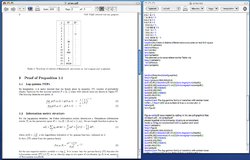TeXShop was developed by American mathematician Richard Koch. It was modeled on NeXTstep's bundled TeXview.app and developed for the then new macOS user interface Aqua and capitalized on the native PDF support of that version of the Macintosh operating system, [1] which was itself based on NeXTSTEP's successor OPENSTEP. Mitsuhiro Shishikura added a Macro editor, a magnifying glass for the preview window, and the ability to transfer mathematical expressions directly into Keynote presentations. Lacking the TeX eq → eps Service which TeXview afforded, other apps such as LaTeXiT.app were developed to provide Service support. TeXShop requires an existing TeX installation and is currently bundled with the MacTeX distribution.
Version history
The MacOS "Tiger" version of TeXShop is capable of jumping from preview to code and vice versa without pdfsync.sty, using the PDF search technology built into Tiger.
Starting with version 2.18, TeXShop also has included support for SyncTeX. This technology also allows jumping from preview to code and vice versa without including any special style file, but is much more reliable than PDF search, especially for documents that include mathematical formulae.
Version 2.26 in universal binary (PPC+x86) was released on 17 March 2009, requiring Mac OS X 10.4.3 or later with Mac OS X 10.5 recommended. Version 2.28 was released on 7 November 2009 as part of the TeX Live 2009 release of MacTeX.
For users of Mac OS X 10.2 and 10.3, Release 1.43 remains available (as well as v1.35e and 1.19 for 10.1.5 and earlier).
For users of Mac OS X 10.4 through 10.6, Release 2.47 remains available (10.5 or higher is strongly recommended).
As of Release 3.39, a new TeXShop dock icon, designed by Thiemo Gamma, has been used. In Finder, TeXShop documents will still use the original icon (designed by Jérôme Laurens and later re-constructed by William Adams for its use with retina displays) for associated LaTeX documents.
Available releases:
5.47: Intel and Arm, High Sierra through Sequoia (11/06/2024)
4.79: Sierra and above
4.44: Yosemite through Big Sur
2.47: Systems 10.4, 10.5, 10.6
